|
Royal Air Servicing
Commandos 1942 - 1946.
Aircraft Ground Crew with Commando Training
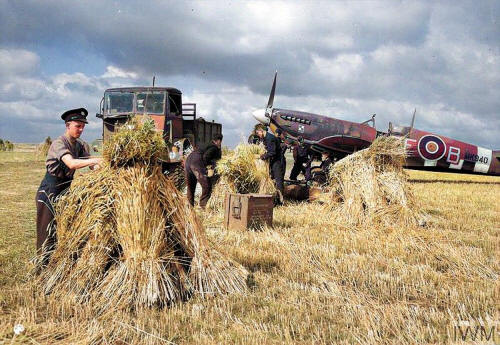 Background Background
The Royal Air Servicing Commandos were trained to do two jobs. The first was to maintain,
repair, refuel and arm operational Allied aircraft during the assault phase of a
major landing close to the advancing front line.
[Colourised Photo; Mechanics of No 3206 Servicing Commando RAF garner wheat for
collection and removal from a dispersal area needed for aircraft at B5/Le-Fresne Camilly,
Normandy. Behind them, armourers attend to a Supermarine Spitfire Mark IX (ZF-B
MK940) of No 308 Polish Fighter Squadron.
© IWM (CL 600)].
The second was to vigorously defend themselves and the aircraft in their charge against enemy attack. The additional training they needed
for this
included two weeks at the No 1 Combined Training Centre, Inveraray on Loch Fyne
in Scotland.
The wartime work of the RAF Servicing Commandos
is less well known than their Army, Marine and Navy counterparts. They kept
operational aircraft flying in support of the advancing troops until
the arrival of the squadrons' regular ground
personnel. In the case of Normandy,
the Units were regularly on the move as the
front line advanced eastwards towards Germany
The volunteers were recruited from the service personnel of RAF
Squadrons through notices posted at RAF Stations; 'Volunteers wanted in all trades for units to be formed to
service aircraft under hazardous conditions.' Despite the lack of
detail, there was no shortage of volunteers prepared to undertake their vital
work in the battle grounds.
Planners identified a need to provide forward aircraft servicing support
during the assault phase as the Allies
advanced through enemy occupied territory. It would take time for squadron ground crews to reach
forward positions so small self contained, mobile servicing units were needed
to fill the gap. A memorandum from the War Cabinet
Annex in Whitehall to the MOD, dated 27/1/42, recommended the formation of an
RAF Servicing Commando Force. The memo was signed by Lord Louis Mountbatten,
Commodore of Combined Operations. The Commandos were required to set up operations, under fire if
necessary, including fuel, spare parts and ammunition for the servicing of
engines, guns and air-frames... and all from tools and equipment carried through
an assault landing! They would also assist during assault landings as necessary.
Formation
Fifteen such units were formed, each commanded by an engineering
officer and usually with an armament officer and an adjutant. Each unit
comprised about 150 men organised into four flights similar to army platoons.
There was a flight sergeant with corporals as section leaders. A sergeant was
responsible for each trade, such as engine, airframe and armourers.
Fifteen 3-ton trucks held each unit's equipment and personnel when on the move.
There was also a 15 cwt (3/4 of a ton) vehicle, a jeep for the Commanding
Officer and a motorcycle for the unit despatch rider. Airmen were armed with Sten guns or rifles and each flight had a Bren gun.
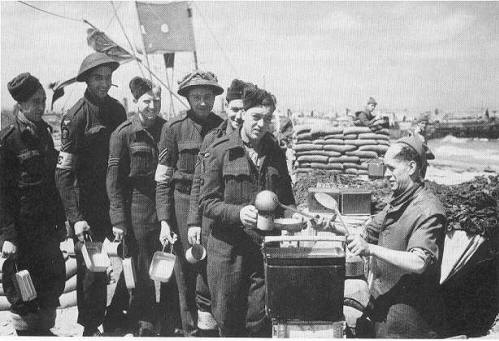 Training Training
All ranks undertook military training, supervised
by Army Officers seconded for the purpose. Their training included driving and
swimming, the former because they were a mobile unit and the latter because they would be involved in amphibious landings. After this initial 'toughening up' training, they spent two weeks at the Combined Training Centre
(CTC) at Inveraray in Scotland.
CTC Inveraray
specialised in minor landing craft amphibious training but was also a location
for Commando training . Here the volunteers trained to safely embark and
disembark landing craft, including the use of scrambling nets, together with physically demanding assault exercises in the surrounding
rugged, mountainous countryside, which usually followed mock landings. On completion of this
training, the coveted Combined Operations badge was issued.
During the following few months, the units frequently moved from
airfield to airfield to gain experience of servicing a wide range of aircraft
including Spitfires, Typhoons, Mustangs and Mosquitoes. Each Commando Unit had a
mobile workshop, which was amongst the first vehicles to go ashore in assault landings,
while fuel tankers and ancillary vehicles landed later
in the day. The object was to establish a landing strip ready to receive
aircraft flying in support of the ground forces.
General Deployment
The Commando Units were deployed in three distinct geographical areas
during the years 1942 to 1945. These were:
The Mediterranean.
Commando
Units 3201, 02, 03 and 04 took part in operations in North Africa, Sicily and
Italy. In addition 3230, 31 and 32
trained in Palestine
and served in Sicily and Italy.
Normandy.
3205, 07, 09 and 10 embarked at Gosport on the
south coast of England early on the morning
of 6th June, 1944. They crossed the Channel on an American Landing
Ship Tank (LST) and several Landing Craft Tank (LCTs), one of which was torpedoed and set on fire
during the crossing. Two airmen were injured but they returned safely to England
by naval craft along with others rescued.
South East Asia.
After
withdrawal from Normandy, the four units (3205, 07, 09 and 10) embarked for
passage to South East Asia. However, the operational life of the units came to an abrupt end with
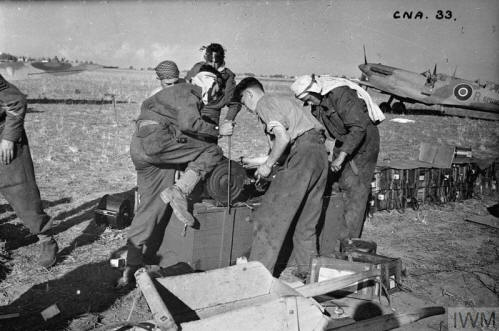 the unexpected surrender of Japan
on 2/9/45. Operation Zipper, the invasion of Malaya, in which they would have
been involved, was cancelled with the ending of the war. the unexpected surrender of Japan
on 2/9/45. Operation Zipper, the invasion of Malaya, in which they would have
been involved, was cancelled with the ending of the war.
[Photo; Operation
TORCH: airmen of No 3201 Servicing Commando loading ammunition drums for the
Supermarine Spitfire Mark Vs of No. 322 Wing RAF at Maison Blanche, Algeria.
Operation TORCH was the first occasion on which RAF Servicing Commandos were
used. Their duties were to undertake the servicing and replenishment of aircraft
during the assault stage of an operation, until the arrival of the squadrons'
ground personnel. © IWM (CNA 33)].
Unit Deployments
Commando Unit 3201 trained in the UK and landed in North Africa on D-Day at about H + 60
minutes and reached Maison Blanche airfield at 09.10 hrs. When not involved in
assault landings, the unit worked alongside aircraft recovery units. They were in
Sicily in 1943 and Corsica in January 1944. Their CO throughout the 2.5 years
was Flt Lt H Webster, who made this critical comment... the unit was misused
after Sicily, no one on the staff knew its capabilities. More information
here.
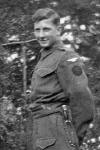 Commando Unit 3202
trained in the UK and served in North Africa and Italy. It was disbanded in
December, 1943, at Taranto, Italy. Commando Unit 3202
trained in the UK and served in North Africa and Italy. It was disbanded in
December, 1943, at Taranto, Italy.
Commando Unit 3203
trained in the UK and served in North Africa,
Sicily and at Salerno in Italy, where they serviced any fighter aircraft that
came their way. They were
disbanded at Portici, Italy in February, 1944.
Commando Unit 3204
landed in Sicily in July, 1943 and disbanded at Catania,
Sicily
on 3/2/44.
[Photos; Left,
3204's LAC Henry John Clifford Elcome, 'Cliff' to his friends, taken
sometime in 1943/44 and below right, Flt Sgt F C Gilbert, Italy, 1943].
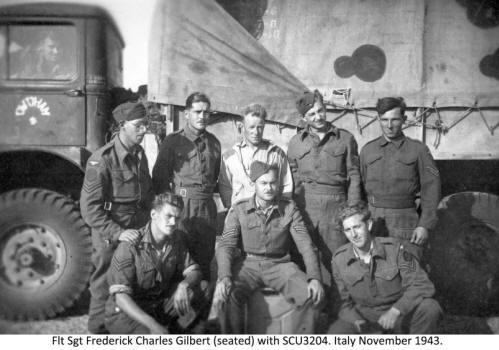 Commando Unit 3205
embarked at Gosport early on the morning of 6/6/44.
They landed on the Normandy beaches on D+1. One vehicle hit a mine on leaving
the landing craft, resulting in 2 fatalities. Commando Unit 3205
embarked at Gosport early on the morning of 6/6/44.
They landed on the Normandy beaches on D+1. One vehicle hit a mine on leaving
the landing craft, resulting in 2 fatalities.
The unit serviced Spitfires during
June. They sailed for India on 2/11/44 with 07 arriving in Chittagong, India on 5/12/44.
They landed at Akyab in January, 1945 from Landing Craft Mechanised
(LCMs). They subsequently operated on the Arakan
peninsula.
In early September, 1945, the unit was at sea bound for Morib
in Malaya. As planned, they landed there on or around September 9th a few days
after the surrender of Japan. Their landing was unopposed and they moved on to Kelanang. Later, the unit was posted to Batavia, now Jakarta, in Java,
by way of Singapore. They were disbanded on February 28th, 1946.
Commando Unit 3206
landed in Normandy on D + 10 and operated through
France to Belgium. They were disbanded in April 1945.
Commando Unit 3207.
The day by day account below was written by
Sgt Tom W Edwards, 637669,
RAF
Servicing Commando
Unit
3207. He
landed
on Gold Beach on
D Day plus 1. Apart from expanding
abbreviations and acronyms, for ease of understanding, the entries are as written by
Sgt Edwards.
June 5 -
14.00 Left
camp area
for mooring area.
June 6 -
04.00 Left
mooring area
for embarkation area (Fareham).
Last on D Day!
11.30 Embarked.
June 7 -
08.40 French
coast sighted.13.00 Hove to five miles out.
Anti aircraft
activity in night.
No enemy aircraft.
Fire in aft hold put out.
Received American
cigarettes, chocolate
and gum ration.
% of unit landed on Landing Craft Tank
(LCT) and % torpedoed off coast
LAC
killed (Leading
Aircraftsman).
June 8 -
Turkey
for dinner. Grapefruit, fruit salad and white bread for previous meal.
16.00
Landed on beach and
wagon
bogged in sand and eventually towed
clear by
Royal Engineers (REME).
Proceeded vehicles
to
assembly areas and
first French sign was a notice
“Pension Famila” on a
house. Local inhabitants waved and cheered.
Proceeded to
Rest and Recuperation Station (RRS)
and slept in wagon.
Heavy ach-ach overnight.
Bazenville.
June 9 -
Fairly easy day.
Stores, ammo & octane
coming in from beaches.
Inspected dump of German
Tellermines
& stick
grenades.
Heavy ach-ach overnight.
June 10 -
Exceptionally
busy day preparing changes
on strip. French women snipers
reported in locality.
Seafire and Typhoon
crash landed
on strip.
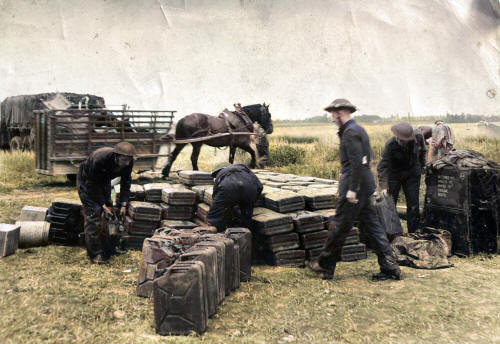 June 11 -
Runway
unusable. Reccy for German. June 11 -
Runway
unusable. Reccy for German.
June 12 - Liberator touched down and crew, apart
from 2, baled out. Royal
Engineer caught sniper in woods at rear of
strip. He
had been supplied with food &
clothing by
French civilians. Obtained eggs
from French farmer for
ten francs late in evening.
[Colourised Photo; RASCU 3205
setting up a fuel dump in Normandy. Courtesy of Andy Kay whose father,
Bill, served in the unit].
June 13 -
First squadron on strip
- Spits.
06.30
Five Dakotas landed with WAAF
orderlies.
Two
Thunderbolts landed
- one pranged.
Two Mitchells shot down in
evening by
anti-aircraft fire.
June 14 -
One Typhoon pranged. Two Typhoon
squadrons and one Spitfire
squadron and five Mustangs.
June 15 -
Two Typhoon and one Spitfire
squadron in.
Heavy ach-ach
overnight. 365 sorties for the
day.
June 16 -
Three
Focke
Wulf 190s hedge hopped
with twelve more above
them over strip. More
Dakotas arrived to transport
wounded. One German
soldier had lost two eyes and a
hand. Air Force took
over at midnight. Two Typhoon and
two Spitire Squadrons
in. Liberator & Lightning, both
shot up, landed on strip.
June 17 -
Left strip at 3pm for
Vaux-sur-Seulles. Went to
village in evening and
had cognac and citroen.
Total
prangs on strip for
five days - Five Spitfires,
Four Typhoons.
June 18 -
Day of rest. Haircut, hair
washed, bath in bowl and
two sets of laundry
cleaned. Petrol, ammo & oxygen
in for strip in evening.
June 19 -
Convoys in during day with
stores for new strip. Went to cafe in village and
indulged in vin blanc and black
coffee.
June
20 -
15.45 Strafed on strip
while unloading stores by
six Focke Wulf 190s.
Heavy ach-ach. Junkers 88 crashed 1/2
mile away and
bomb load exploded. Went to Vaussiex and had
six vin blancs in cafe.
June
21 -
Went over to crashed
aircraft in
evening. Wreckage and
bodies strewn over wide area.
June
22 -
Main Caen-Bayeux road
shelled in afternoon 1/2
mile from strip. 19.30
Unidentified
aircraft crashed near
strip and five of crew
baled out safely. Formation of
Mitchells seen over
Caen
flying through heavy anti-aircraft
fire
- one shot down.
June
23 -
Machine gunned on strip by
Focke
Wulf 190 at 15.00 flying
at zero feet. Corporal Boyce
opened up with Bren
gun. Operated on
19 Squadron Mustangs.
June
24 - 27 -
Nothing exceptional. Work on
Mustangs.
June
28 -
Four ME 109s came in low over
site
at 13.45 and opened fire without
causing casualties or
damage.
June
29 -
Moved to RSU Meuvaines at
seven p.m. Crash
strip
-
which first
aircraft landed in France.
June
30 -
Crated 12
aircraft for return by
Landing Ship Tank (LST)
to England with
USA Fisher100
&
75c
aircraft
and cargo.
Jul
1 - Inspected
dump of 28cm & 32cm Incendiary
Rocket Bombs & Bangalore Torpedos.
Carried on with armament
maintenance.
Jul
2 - 6 - Cleared lanes for aircraft
category lines. Prepared
machine guns and carriers for shipping.
Jul
7 - Demolished Bangalore Torpedo &
Rocket Propelled
Heads. Saw Lancasters &
Halifaxes
go in over Caen. Heavy
anti-aircraft fire,
2 Lancasters shot down, crews
baled
out.
Jul
8 - Visited Bayeux. Brought
gifts;
slips 400f,
blouse
150f,
stockings 165f,
handkerchiefs 38f.
Amazing experience.
Jul
9 - 12 - Organised classes for
Mines Exhibition at Bayeux.
Heavy fire over Caen
on all three nights. JU (Junkers)
88
machined gunned
beaches.
Jul
13 - Visited
Caen to collect & dispose of
German target indicators from
Cargoes. Whole village
blasted and all buildings
destroyed.
Dead horses and cattle in farmyards. Personal belongings &
property left in houses and air of desolation everywhere.
Caen finding its
feet again.
Jul
14 - 19.30 Dog fight overhead.
Enemy formation in clouds
scattered when Spitfires
appeared. ME109 shot down by
Spitfires and pilot
baled
out.
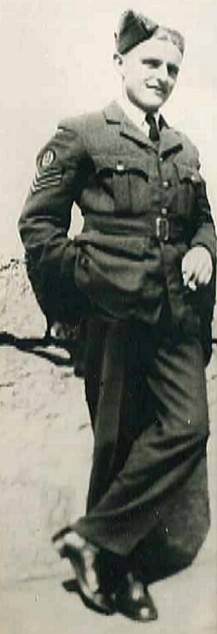 After 18 year old Tom Edwards
joined
the
RAF in early 1939,
he
served in many RAF
Stations and other
locations including Cranwell, Manby,
Donna Nook (Hawker
Demons), Farnborough, Hullavington (Maintenance
Unit), Zeals, Redhill (3
Bomb Disposal Squad), Carew
Cheriton (43 Bomb Disposal Squad), Manston, Tangmere, West Hampnet,
Shoreham (Rest & Recuperation),
Inveraray
(Commando
Training),
Normandy (landing
on Gold
beach on D Day + 1),
Eastchurch (Isle of Sheppy),
Egypt (Masarah Maintenance Unit) and Palestine (Coastal Bombing Range). After 18 year old Tom Edwards
joined
the
RAF in early 1939,
he
served in many RAF
Stations and other
locations including Cranwell, Manby,
Donna Nook (Hawker
Demons), Farnborough, Hullavington (Maintenance
Unit), Zeals, Redhill (3
Bomb Disposal Squad), Carew
Cheriton (43 Bomb Disposal Squad), Manston, Tangmere, West Hampnet,
Shoreham (Rest & Recuperation),
Inveraray
(Commando
Training),
Normandy (landing
on Gold
beach on D Day + 1),
Eastchurch (Isle of Sheppy),
Egypt (Masarah Maintenance Unit) and Palestine (Coastal Bombing Range).
[Photo; Sgt Edwards in Alexandria, Egypt,
early 1945].
He volunteered for
bomb
disposal
training and from Redhill took part in 17 operations
between 24/12/40 and 14/05/41. In 1943 he volunteered for
service of a hazardous nature in
the RAF Servicing
Commandos.
In
December 1944, 3207 arrived
in India, spending Xmas 1944 at Imphal where,
together with No 3 R&SU, they engaged in recovery and salvage work. In February, they moved by road to Monywa,
where part of the unit was later flown
into Meiktila in Burma. Here, they occupied a landing strip inside a defensive
box. They were joined by the RAF Regiment, who assisted in the defence of the box. During this period, both Sgt. Brown and Nobby Coxhall, who had served in Normandy with 3209, earned the Military
Medal.

The part unit was withdrawn from Meiktila on 29/4/45.
After the fall of Mandalay, the unit left for Mingladon which, by then, was
securely in Allied hands. They then moved to Rangoon where they took part in a victory parade.
They then
sailed to Singapore, arriving there on September 5th. Prior to being
disbanded (possibly at Kallang) on 31stMarch 1946, 3207 serviced planes used to repatriate ex POWs
(prisoners of war).
[Photo; Royal Air
Force Servicing Commandos prepare to go ashore from a troopship at Singapore.
Their task was to clear airfields and prepare them to receive the first Allied
aircraft. © IWM (CI 1605)].
Commando Unit 3208 landed in Normandy on D + 10, where they
serviced Mustangs and other aircraft. They moved to forward airfields with
the advancing Allied troops and serviced Mosquitoes covering the Rhine crossing.
They were disbanded in March 1945.
Commando Unit 3209. Most of 3209 sailed
from Gosport on an American LST with the remainder of the unit on an LCT
together with all the unit's cooking equipment. Unfortunately the LCT was sunk
by enemy action and two airmen were killed and others injured. Most were
picked up by naval craft and returned to England but one member was
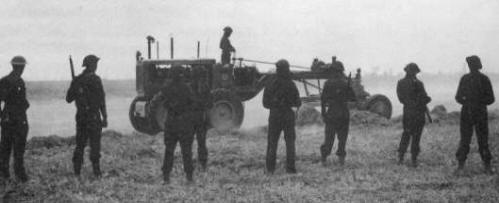 deposited
on his designated landing beach in Normandy ahead of the main body of men.
On their arrival, he admonished them with, “Where have you lot been?”, while
resplendent in a naval jersey given to him by one of the sailors! deposited
on his designated landing beach in Normandy ahead of the main body of men.
On their arrival, he admonished them with, “Where have you lot been?”, while
resplendent in a naval jersey given to him by one of the sailors!
[Photo; Servicing Commandos watching a
bulldozer clearing ground for the first new landing strip in Normandy].
Because
the unit had lost all its cooking equipment, for several weeks they survived on canned compo rations delivered
to them on crates containing food for 14 men for one day. For cooking and
heating water, they used empty motor transport fuel
cans, cut in half, filled with earth and soaked in petrol. When replacement cooking
equipment arrived, the unit cooks resumed their duties.
The units operated mostly on the B2 and B3 landing
grounds in Normandy, returning to England at the beginning of August. They were
given leave before sailing for the Far East at the end of the year.
On landing in Bombay in January
1945, 3209 spent some time in a transit camp possibly called Worli. From there,
they crossed India to Singabeel in the state of Assam; to Calcutta, for a short stay
on the Midan; back across India to a Seaplane base at Korangi Creek on the coast
not far from Karachi. Here they underwent some training on landing craft but
spent most of the time swimming! Once more across India to Bobbilli on the coast
north of Madras, where they waited for the delivery of some Bedford trucks, then
down to Madras and aboard a Tank Landing Craft (TLC) to Rangoon.
They were scheduled to take
part in Operation Dracula... the seaborne assault on Rangoon but this was
cancelled upon the surrender of the Japanese in early September 1945. 3209 was
then split up and never again operated as a unit.
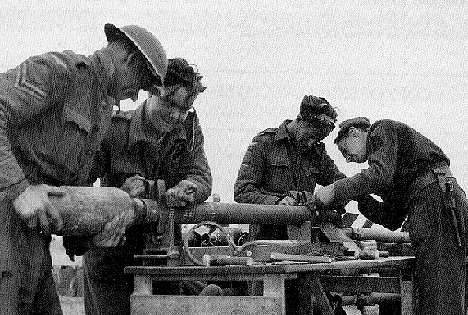 A Squadron (1 and 2 flights) sailed to Rangoon from Madras and
then to Bangkok by landing craft, where they established a staging post for
servicing visiting aircraft. A Squadron (1 and 2 flights) sailed to Rangoon from Madras and
then to Bangkok by landing craft, where they established a staging post for
servicing visiting aircraft.
B Squadron (3 and 4 flights) sailed
from Rangoon to Saigon on board the troop ship 'Silesia.' It was not altogether
safe, since Nationalists fired on a following vessel on the Saigon River. They
established the No 2 staging post for aircraft en-route to Japan and also
took part in airfield defence against insurgents seeking to prevent the return of the
French.
[Photo; Armourers making up rockets for
Typhoons].
The squadron also patrolled the countryside looking for
terrorists and arms and they provided a guard of honour for Lord Louis Mountbatten on his
arrival in Saigon. 3209 was disbanded on 22nd November 1945 and members were posted to RAF
units throughout South East Asia.
Commando Unit 3210 landed in India on 14/1/45 and, after training at Worli,
moved to Calcutta. Flights were employed at various stations until orders came
through to prepare for Operation Zipper. However, the surrender of the Japanese
on 5/9/45 changed everything. In mid September they sailed to Malaya
on board the SS Dunera and on the 17th, they transferred to landing craft
off Morib beach, having to negotiate four feet of water and a nine mile march
to their assembly area!
On
this subject reader
Neville Colfer writes;
The SS Dunera arrived off Morib Beach
on the 9th according to the log of my father's RAF squadron - the 89th Squadron.
They also transferred to LCIs and then another transfer to smaller landing craft
before wading ashore on the afternoon of the 9th. They set off on a 10 mile
march to a transit camp at Telok Datok, same one as the 3210, I expect. But it
was too late in the day and so they were ordered to
bivouac.
It was so dark they couldn't see where they were setting up their tents.
Unfortunately, some erected their tents on a dry river bed which, unbeknown to
them, was subject to flash flooding. They woke up during the night in several
inches of water! Overnight monsoon rains thoroughly soaked them and all their
kit. When they arrived at Telok Datok, which was no more than a collection of
huts, it took two days to dry out!
Their orders
were to prepare airstrips at Port Swettenham or Port Dickson, ready for
operational duties by the 15th September when new mosquitoes were due to arrive.
This was also what, I expect, 3210 were going to do under fire, if
opposed. However, all that had changed, of course, with the end of the war. With
war plans abandoned, the 89th Echelon received new orders on the 23rd of
September to "Make your way to Seletar, Singapore".
42651 personnel and 3968
vehicles were landed on Morib beach according to a monument erected there by the
46th Indian Beach Group.
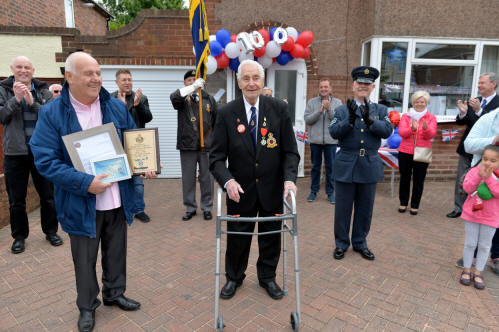 Aircraft were serviced at airfields in Port Swettenham and Kuala Lumpur's Kelanang
airfield. On the 21st of September, a move to Batavia in Java was intimated and, shortly thereafter, they sailed from Port Dickson to Batavia, with their vehicles, aboard four LCTs.
On arrival they took over airfield defence from an army detachment and serviced incoming
aircraft and, initially, two squadrons of Thunderbolts. With little notice, the
unit was disbanded on 31 October, 1945. Aircraft were serviced at airfields in Port Swettenham and Kuala Lumpur's Kelanang
airfield. On the 21st of September, a move to Batavia in Java was intimated and, shortly thereafter, they sailed from Port Dickson to Batavia, with their vehicles, aboard four LCTs.
On arrival they took over airfield defence from an army detachment and serviced incoming
aircraft and, initially, two squadrons of Thunderbolts. With little notice, the
unit was disbanded on 31 October, 1945.
[SCU 3210 veteran Desmond Spruce celebrates
his 100th birthday on 13/05/20].
SCU 3210 comprised
around 150 men split into 4 flights of around 40 men each. It is
remarkable, therefore, that within 9 months two of their number celebrated
their 100th birthdays. We were invited to contribute to their celebrations
by providing an honorary Combined Operations Membership Certificate and a
letter of appreciation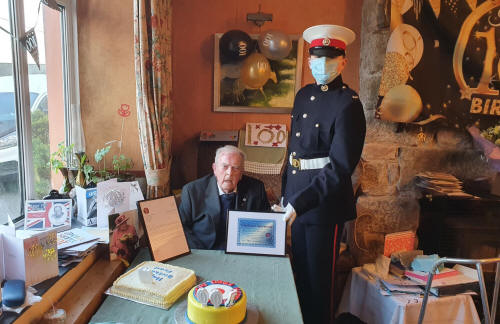 which read;
which read;
It’s with
a sense of honour and pride that I’m able to send you an honorary membership
certificate from the Community that has built up around the Combined Operations
website over the past 20 years.
[RCU 3210 veteran Fred Hammett celebrates
his 100th birthday on 03/02/21 poignantly attended by a Royal Marine
Cadet about the age Fred was when he joined the RAF early in 1941].
The RAF
Servicing Commando Unit 3210, in which you served, armed, fuelled, serviced and
repaired Allied aircraft often under dangerous and difficult operating
conditions close to forward positions. This provided vital air support for our
ground forces when it was most needed.
Records show that Service
Commando Unit 3210 was formed in April 1943 from men of the RAF Fighter Command and served in
Normandy, India, Burma, French Indo-China, Malaya, Thailand and Java.
On behalf of a grateful nation, I thank you for your service and wish you a very
happy 100th birthday.
Yours sincerely,
Geoff Slee
Partly due to an appeal on the
Combined Ops Facebook page,
Fred received almost 600 birthday cards, messages and gifts.
Commando Unit 3225 was formed in the UK in July 1943 and served in Egypt
around the end of 1943.
Commando Unit 3226
was formed in July 1942. They served in
Sicily and Salerno, Italy where, despite the airstrip coming under enemy
fire, fuel was successfully transported from the beachhead area to keep
Allied planes flying in support of ground forces. After further service,
the unit was disbanded in January 1944. They suffered one
fatality
- 1107082, CPL Hugh McCulloch Montgomerie. RAF (VR), 11 August 1943. Age
26. Catania War Cemetery, Sicily. IF 46.
Commando Units 3230 and 3231
were formed in Palestine
(Egypt?) in the Spring of 1943.
They were deployed to Sicily and the toe of Italy before being disbanded in
November 1943 and January 1944 respectively.
Memories
of D-Day
Gordon Taylor was a member of 3209 on D-Day and recorded these
thoughts on 24th July 1944. His early involvement in the war was seriously
interrupted by a German torpedo!
Sunday 4 June 1944 -
Old Sarum, Salisbury. Hanging around all day. Received £1.00
for changing into 'foreign currency.'
Monday 5 June -
Left
Salisbury at 13.00 hrs and arrived in Portsmouth area after travelling all
day. Loads of work. Collected 24 hour ration packs and changed money into
francs, £2.00 and received 400 francs. Bed about midnight tired out.
Tuesday 6 June -
Up
at 02.45 hours and away by 05.00. With only a few of my mates (unit split
up). On landing craft by 10.00 hrs. Moved off at 14.00 hrs. to join the rest
of the convoy at about 22.00hrs. Bed down in lorries to sleep.
Wednesday 7 June -
At
about 02.00 hrs gunfire heard, all boys reached for tin hats. Suddenly there
was a terrific crash and a tremendous yellow flame lit the whole place up.
In a few seconds there was a large fire going. All I remember was that I
found myself wandering about the deck. Most of the boys had, by now, got
over the first shock, and were standing well to the front as the fire was
spreading and had reached ammunition which was exploding. I went to the
front and found that we were not sinking so I decided to stay on a little
longer. Two chaps, Canadians, dived overboard. I don't think that they were
picked up or seen again.
 The fire was well
alight and we could see chaps trying to get out. I don't think they did. We
could not get down the other end because of the fire and the damage to the side
of the ship. The front half was now rocking about badly as its back was breaking
leaving the top plates holding the two halves together. The fire was well
alight and we could see chaps trying to get out. I don't think they did. We
could not get down the other end because of the fire and the damage to the side
of the ship. The front half was now rocking about badly as its back was breaking
leaving the top plates holding the two halves together.
Suddenly a motor launch came out of the blue
telling us to jump into the water. Not a bad idea but some of the boys' life
belts were punctured by the blast. It then came closer so that we could jump
aboard. It took about ten chaps - two fell into the water but were picked up. We
did not think that it was corning back again but it did a few minutes later and
I was last but one.
At the other end of the boat they were trying to
put the fire out but no water came through the fire hoses. On the rescue boat I
went below after feeling a pain in the head from which blood was flowing. The
boat was crowded with chaps who were badly burned. All of us were sick in the
following hours.
I went on deck after my head was bandaged and all
I could see were hundreds of craft of all sizes. The French Coast stood out very
clearly in the background. The boat went up and down the coast looking for a
hospital ship but when we made contact it was full. We were then transferred to
an LCT, which had another in tow. We stayed with this until we were again
transferred to an American LST on its way back to England. Those of us not
too good were put to bed and given anti tetanus injections. Had some lovely
coffee and tea. Tried to sleep but there was lots of noise.
Thursday 8 June -
Arrived
back in England at about 3 o'clock in the afternoon and was taken to
Winchester Hospital. And was soon asleep.
Gordon was
transferred to hospital in Bradford and was eventually posted to 141 Wing HQ
at West Mailing.
Roll of Honour
RAFSC 3201 - 612453,
Sgt Benjamin Pickering RAF,
17 November 1942. Age 22. Dely Ibrahim
War Cemetery, Algeria. 3H10
RAFSC 3201 - 1240138, AC1 George Clarke. RAF(VR),
22 November 1942. Age 31. Medjez-El-Bab War Cemetery, Tunisia. 6C1
RAFSC 3201 - 1035703, LAC Stanley Arthur Gallagher.
RAF (VR),
22 November 1942. Age 22. Medjez-El-Bab War Cemetery, Tunisia. GC2.
RAFSC 3202 - 618375, Sgt Leonard Victor Snape. RAF,
18 January 1944.
Age 23. Bari War Cemetery, Italy. 15D14
RAFSC 3205 - 1312615, LAC Owen William Swallow. RAF
(VR), 30 January 1945. Age 31. Taukkyan
War Cemetery, Rangoon, Burma. 5C8
RAFSC 3206 - 1384610, LAC Leonard Charles
Lansdowne. RAF (VR),
12 September 1944. Age 32. Marissel French National Cemetery, France. Grave 324.
RAFSC 3207
- 1678283, LAC Jack Henson Crofts. RAF (VR),
7 June 1944.
Age 20. Runnymede Memorial, Egham, Surrey. Panel 241 (Lost at Sea - Normandy
Landings)
RAFSC 3209- 1460523, AC1 Edward John Skeggs. RAF (VR),
8 June 1944. Age
23. Runnymede Memorial, Egham, Surrey. Panel 243 (Lost at Sea - Normandy
Landings)
RAFSC 3209 - 648591, CPL Charles Mervyn Walker.
RAF, 10 October 1945.
Age 23. Madras War Cemetery, India. 9E3 (While rejoining unit in Burma - Siam
area)
RAFSC 3225 - 612613, SGT John Edwin Savage. RAF,
22 October 1943. Age
26. Khayat Berach War Cemetery, Israel. DB6
RAFSC 3226 - 1107082, CPL Hugh McCulloch Montgomerie. RAF (VR),
11
August 1943. Age 26. Catania War Cemetery, Sicily. IF 46.
RAFSC 3231 - 1305857, LAC Ernest Nuttall. RAF (VR),
30 June 1943. Age 22.
Pembroke Military Cemetery, Malta. Plot 5. Row 4. Grave 9
RAFSC 3231 - 1342823, LAC James Renton Taylor. RAF
(VR), 30 June 1943. Age 22.
Pembroke Military Cemetery, Malta. 1117
RAFSC 3232 - 649555, CPL Harold Moore. RAF,
11 May 1943. Age 27. The
Alamein Memorial, Egypt (Column 272) (Lost at Sea - Givate Olga Beach, Israel)
RAFSC 3232 - 1024016, LAC Horace Hughes. RAF (VR),
11 May 1943. Age 23. Khayat Beach War Cemetery, Israel. CB16. (Lost at Sea
- Givate Olga Beach, Israel)
RAFSC 3232 - 1233431, AC1 John William Cannon. RAF
(VR), 21 June 1943. Age 22.
Malta (Capucchini) Naval Cemetery, Malta. Prot Sec (Men's) Plot F
Coll. Grave 36.
RAFSC 3232 - 1172764, LAC Reginald James Alfred Goodman. RAF (VR),
21
June 1943. Age 24. Malta (Capucchini) Naval Cemetery, Malta. Prot Sec (Men's)
Plot F Coll. Grave 36
[Information provided by Tony
Stanhope from "A History of the RAF Servicing Commandos" by J P Kellet
and J Davies].
Further Reading /
Viewing
There are around 300 books listed on our
'Combined Operations Books' page which can be purchased on-line from the
Advanced Book Exchange (ABE) whose search banner checks the shelves of thousands
of book shops world-wide. Type in or copy and paste the title of your choice or
use the 'keyword' box for book suggestions. There's no obligation to buy, no
registration and no passwords. Click
'Books' for more information.
Royal Air
Servicing Commando Unit 3201. A light hearted account of hazardous duties
illustrated with cartoon images drawn by the author.
The RAF Servicing Commando and The
Tactical Wing Association at http://www.tswscdoassn.co.uk/. In 2006 the RAFSC Association joined forces with
today's Tactical Supply Wing to form a new association representing a common
heritage. New members are welcome.
A History of the RAF Servicing Commandos, by J P Kellett
and J Davies, published by Airlife in 1989.
ISBN 1-85310-051-X.
Spectacles, Testicles, Fags and Matches - the untold story of the RAF
Servicing Commandos in World War Two. Written by Tom Atkinson. Published by
Luath Press Ltd, Edinburgh in 2004. The author was a member of RASC Unit
3210.
A 45 minute
Youtube Video about
life in RASCU 3209 as recorded by Jane S Lewis from the audio
reminiscences and photo albums prepared by her late father, Sidney
Richard Lewis.
Correspondence
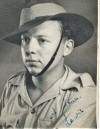 Hello
Geoff, Hello
Geoff,
I've just found your most informative website. I have lived in the USA
since the early 60s having served in the RAF from 1956-1962 starting as an
Apprentice for three years; then RAF Leuchars and RAF Germany.
Both of my uncles were WW2 RAF including LAC Lewis Leo, RAF 1727249 from July
3, 1942 until March 1946. He was a member of 3207 RAF Servicing Commando and
also 7146 Servicing Echelon in India and Burma from November 15, 1944 until it
was disbanded in Singapore in 1946. He left the service in March 1946. He was
specially qualified on Hurricanes, Spitfires and Thunderbolts but, like all
Servicing Commandos, serviced any aircraft that arrived during the Burma
campaign. My other uncle, also RAF, served in Malta from 1940-1943, leaving
the service in 1946.
I am including a photo of Lewis in Burma which I would like to add.
Best regards
Patrick (Patrick J. O'Shea FTS
CTC, USA).
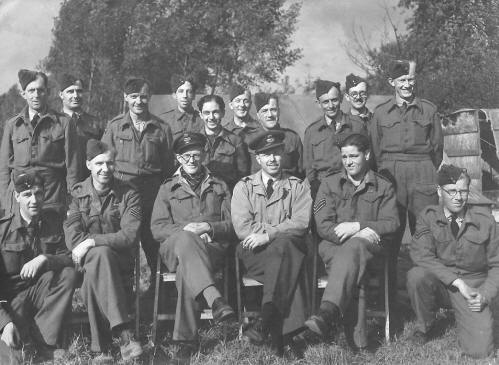 Hi
Geoff, Hi
Geoff,
My Father, fourth from left back row in the
photo opposite, was in the 2nd TAF 121/122 Wing in the RAF Servicing
Commandos. He went over to France on D-Day +2, I think to the airfield at Le
Fresne Camilly. From there he progressed up to Volkel in Holland ending up in
Copenhagen. His official role was as a shoemaker, repairing flying boots etc
but also building, repairing and defending the airfields. The photo was taken
in Holland in October 1944.
Best regards,
Stephen Parker
Hi Geoff,
My grandfather was J P Kellett who co wrote
The History of the Servicing
Commandoes when I was a little girl. I remember him spending many hours
clunking away on an old type writer in the spare room, much to my Nan's
annoyance at times. He mainly wrote it because he felt people may forget the
servicing commandos ever existed in time. My uncle found his book in the
Australian RAF museum so I am guessing he did his part to stop that happening
and I thank you and the others who have set up this website for doing the same.
I will very much enjoy spending time visiting and reading all the interesting
articles in it and thank you again for keeping this part of history and a part
of my granddad I am extremely proud of, alive.
Kind regards,
Stacey Pennington
Copies of the book are usually available
through the 'ABE' link under Further Reading.
Hi Geoff
My uncle, Rod Davidge, flew
with RAF 193 Typhoon Squadron through to September 1944. On June 17th,
1944, Rod was hit by flak at 15,000 feet while on a bombing mission over Thury
Harcourt, about 20 miles from the Normandy beaches in an area south of Caen. The
day before they had lost their Wing Commander, R. Baker, while bombing targets
in the same area, so Rod was now the leader of the group. After the strike,
the squadron were re-grouping when Rod was hit by flak. He was a relatively
easy target as he flew straight and level while waiting for the others to
re-group on him. He handed over the lead to the next in line of command and
shut down his engine to reduce the risk of fire since one of his fuel tanks
had been hit. He considered bailing out but since he was over enemy territory,
he opted to glide his Typhoon towards the coast where Allied forces had taken
up position.
He noticed an airstrip
under construction and made a dead stick landing at what was to become
"B6". His plane raised a lot of dust but he was grateful to be alive and on
the ground. As he casually stepped out of his aircraft nearby service
personnel yelled at him to take cover just before German artillery opened up
on their position. When the action was over, he was greeted by the Servicing
Commandos, possibly 3205 or 3206. They quickly assessed the damage to his
aircraft and within a short time he was ready to go with a patched fuel tank
and enough fuel to reach England. He may have been the first to land and take
off at B6.
He returned to his
operational base in the UK later that afternoon in time for dinner! His
squadron mates thought he'd bailed out, crashed landed, was captured or even
dead, so they were very surprised and delighted to see him in the flesh. He
has always spoken very highly of the Air Servicing Commandos who helped him
that day. At the time of the incident he had no prior knowledge of the SCs but
was so grateful for their support at his time of greatest need following his
own brush with death and the recent loss of his close friend.
193 Sqd. later relocated to
B3 where he continued to fly until the end of his 2nd tour. He was
repatriated to Canada in the fall of 1944 where he continued to fly for the
RCAF as a trainer. He also patrolled the skies in Hawker Hurricanes in Western
Canada searching for Japanese Balloon bombs. At the age of 94, he has had a
wonderful life and continues to live in Ontario.
It would be exciting to
find any record or information of Rod’s landing and the repairs he received
from Servicing Commandos. If you can help, please click on the e-mail link
opposite.
 Cheers, Cheers,
Doug Davidge
 Acknowledgments Acknowledgments
This account of the RAF Servicing Commandos was written by Ed Stevens
with additional material from others.
|






 After 18 year old Tom Edwards
After 18 year old Tom Edwards


 A Squadron (1 and 2 flights) sailed to Rangoon from Madras and
then to Bangkok by landing craft, where they established a staging post for
servicing visiting aircraft.
A Squadron (1 and 2 flights) sailed to Rangoon from Madras and
then to Bangkok by landing craft, where they established a staging post for
servicing visiting aircraft. 





